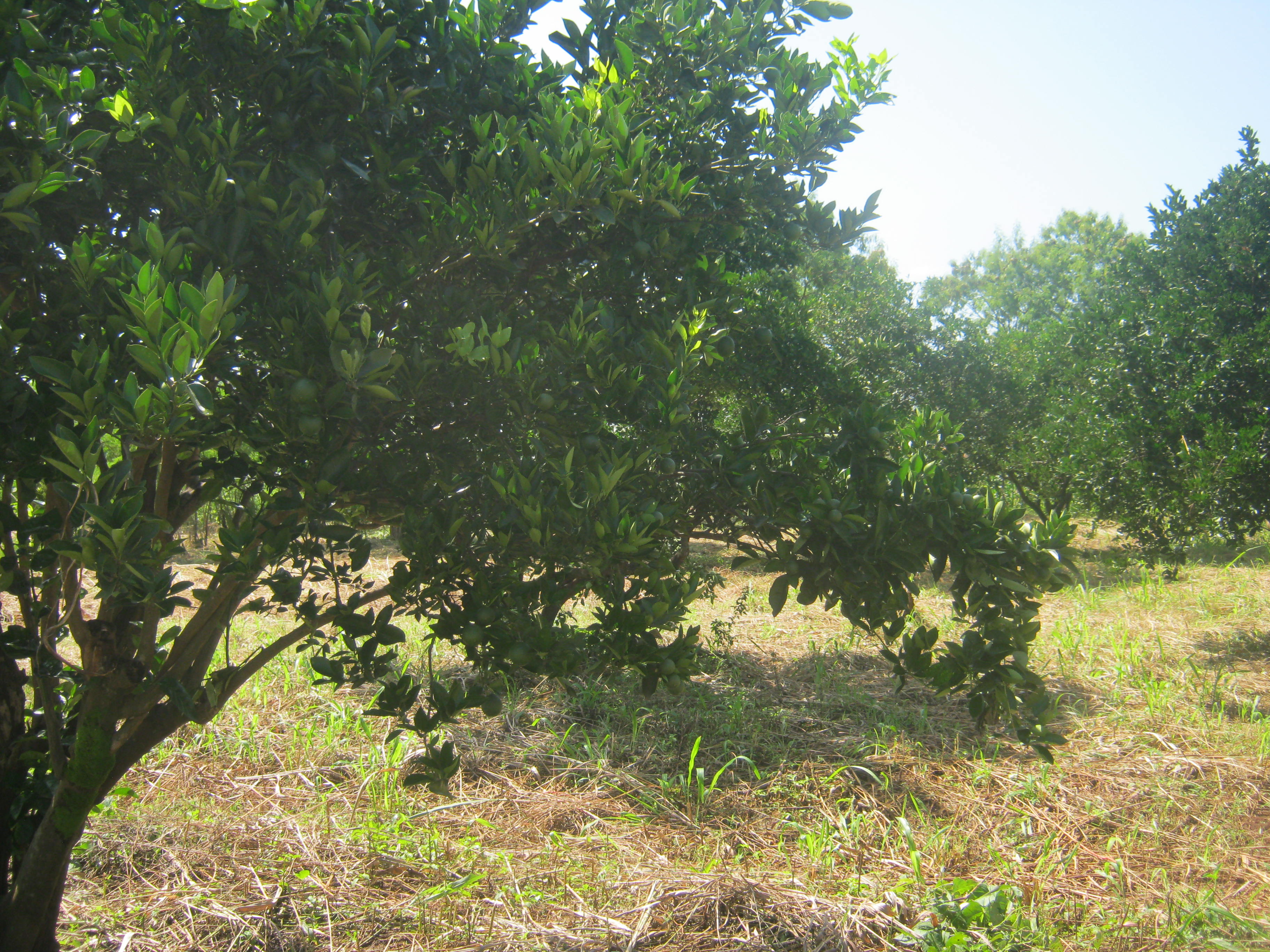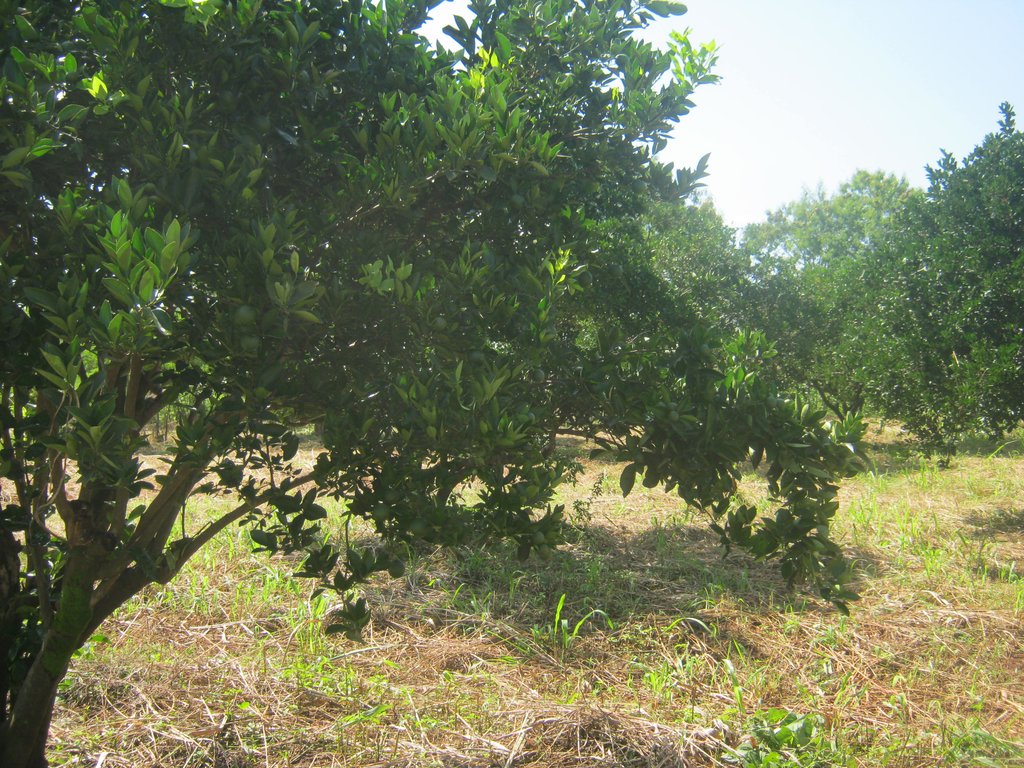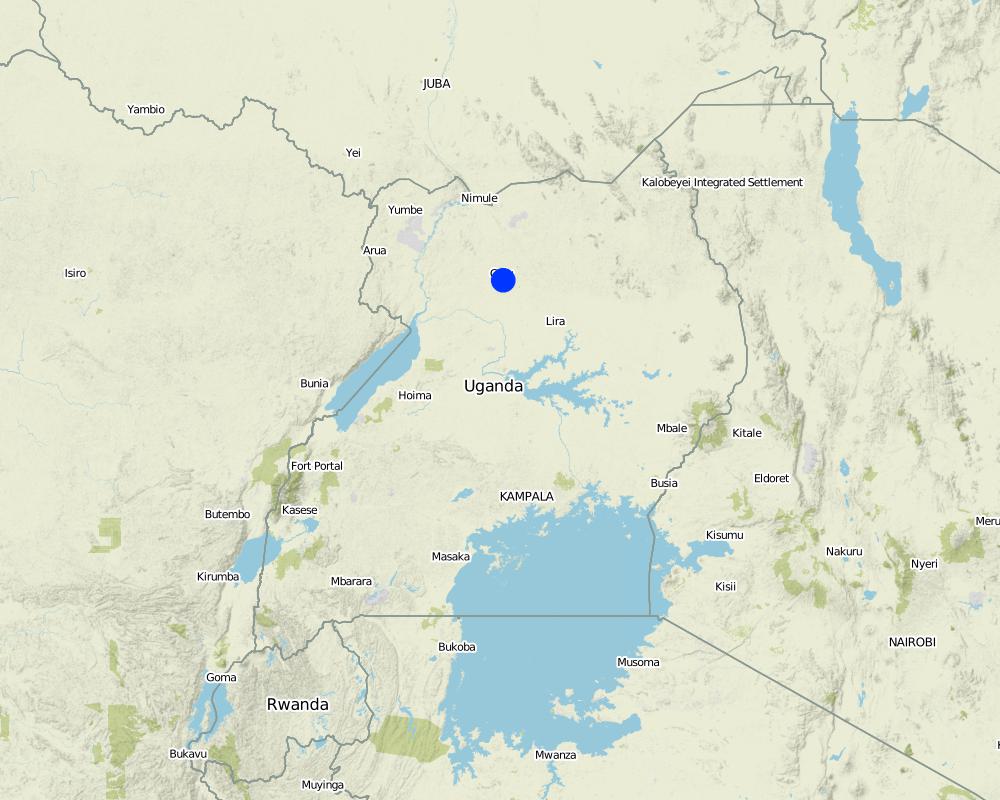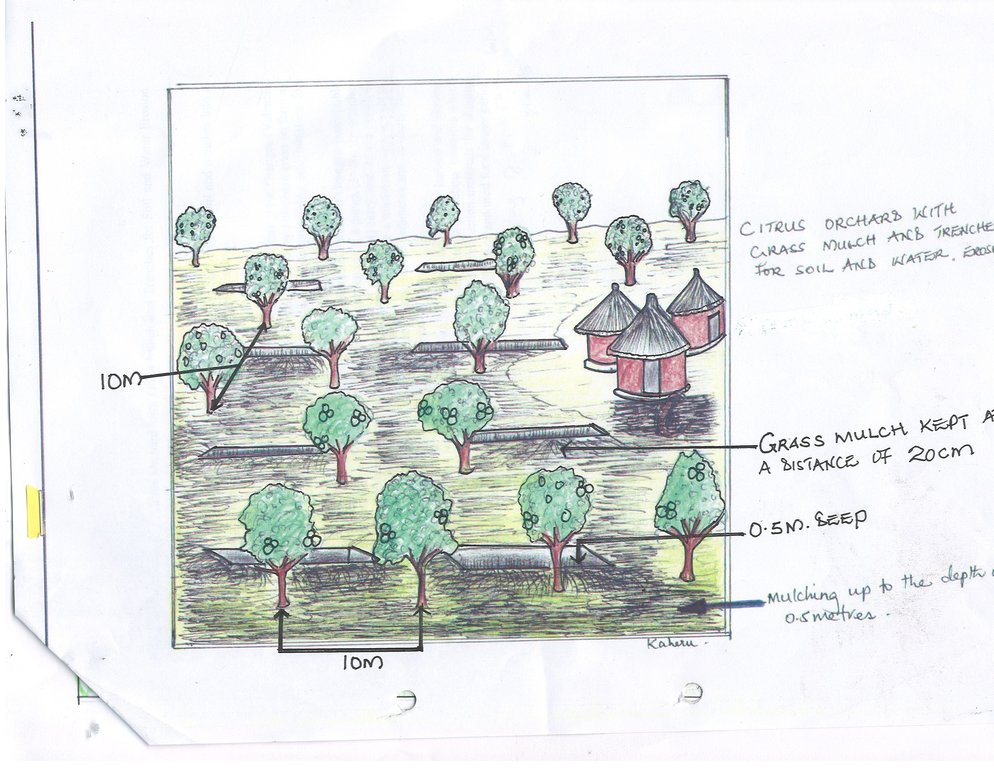Citrus Orchard with Grass Mulch and Trenches for Soil Erosion Control [Uganda]
- Creation:
- Update:
- Compiler: Kamugisha Rick Nelson
- Editors: JOY TUKAHIRWA, Richard Otto Kawawa, Sunday Balla Amale, Bernard Fungo
- Reviewers: Drake Mubiru, Nicole Harari, Renate Fleiner
Poto mucungwa , magiumu kilum pi gengo kitete
technologies_2826 - Uganda
View sections
Expand all Collapse all1. General information
1.2 Contact details of resource persons and institutions involved in the assessment and documentation of the Technology
Key resource person(s)
land user:
Oduor Alex w
0779835993
Farmer
Gulu
Uganda
Name of project which facilitated the documentation/ evaluation of the Technology (if relevant)
Scaling-up SLM practices by smallholder farmers (IFAD)Name of the institution(s) which facilitated the documentation/ evaluation of the Technology (if relevant)
Uganda Landcare Network (ULN) - Uganda1.3 Conditions regarding the use of data documented through WOCAT
When were the data compiled (in the field)?
2/4/2017
The compiler and key resource person(s) accept the conditions regarding the use of data documented through WOCAT:
Yes
1.4 Declaration on sustainability of the described Technology
Is the Technology described here problematic with regard to land degradation, so that it cannot be declared a sustainable land management technology?
No
2. Description of the SLM Technology
2.1 Short description of the Technology
Definition of the Technology:
Integrating black spear grass (Heteropogon Contortus), elephant grass (Pennisetum Purpureum) and trenches into a Citrus orchard of Oranges (Citrus Sinensis) for soil and water erosion control.
2.2 Detailed description of the Technology
Description:
Farmers in Northern Uganda with an average size of 0.5 acres of land or more grow Oranges (Valencia and Anlin) varieties planted with a spacing of 10 x10 m and integrate them with the use of locally obtained black spear grass and elephant grass on farm as mulching materials and trenches to slow down rainwater runoff while preserving soil moisture for increased production and household income. Citrus orchard of oranges (Citrus sinensis ) with grass mulch and trenches is established on gently sloping land with grasses every year. The trenches are established within the citrus orchard for soil erosion control and environmental and water conservation.To establish this technology the land user will (1) identify an already planted Orchard of Oranges susceptible to soil and water erosion problems, (2) clear the grasses in the garden using a panga, (3) dig the trenches using a hoe, a spade and labour up to a depth of not more than 0.5 centimetres, (4) carry and lay the mulch to the garden using at least 3-4 workers per day with the grass mulch kept at a minimum distance of 20 centimetres away from the plant to allow for air circulation, (5) remove the sediments and re-apply them back to the field once the trenches are filled with the sediments. Mulched grass decomposes over time, improves fertility while trenches allow water harvesting and prevent soil and water erosion. However, the land user needs to be aware that trenches are labour intensive which could be the most expensive input, in addition to the cost of basic construction materials for digging trenches like a hoe, a panga and a spade which are in most cases bought once and used for a longer period of time. The benefits derived from this SLM technology are high in the long run as the technology is suitable for improving soil fertility and controlling soil erosion with the established grass mulch and trenches. Trenches and grass mulch retain water during heavy rains which is utilized by citrus during the dry season. The leaf litter from a citrus garden with minimum tillage when decomposed provides manure to enhance crop production generating increased income from the sale of fruits. However, this technology requires labour for planting, cutting the grass , watering and constructing the trenches which accounts for most of the costs. What is not liked about this technology is that the trenches are not easy to make and are labour-intensive.
2.3 Photos of the Technology
2.5 Country/ region/ locations where the Technology has been applied and which are covered by this assessment
Country:
Uganda
Region/ State/ Province:
Northern Region,Uganda
Further specification of location:
Gulu District
Map
×2.6 Date of implementation
Indicate year of implementation:
2011
If precise year is not known, indicate approximate date:
- less than 10 years ago (recently)
2.7 Introduction of the Technology
Specify how the Technology was introduced:
- through land users' innovation
3. Classification of the SLM Technology
3.1 Main purpose(s) of the Technology
- improve production
- reduce, prevent, restore land degradation
- adapt to climate change/ extremes and its impacts
- create beneficial economic impact
3.2 Current land use type(s) where the Technology is applied

Mixed (crops/ grazing/ trees), incl. agroforestry
- Agroforestry
Main products/ services:
Orchard of Oranges
3.3 Further information about land use
Water supply for the land on which the Technology is applied:
- rainfed
Number of growing seasons per year:
- 2
Specify:
Twice a year: April-May and August-November
Livestock density (if relevant):
N/A
3.4 SLM group to which the Technology belongs
- agroforestry
- integrated soil fertility management
3.5 Spread of the Technology
Specify the spread of the Technology:
- evenly spread over an area
If the Technology is evenly spread over an area, indicate approximate area covered:
- < 0.1 km2 (10 ha)
3.6 SLM measures comprising the Technology

agronomic measures
- A1: Vegetation/ soil cover
- A2: Organic matter/ soil fertility
- A3: Soil surface treatment

vegetative measures
- V1: Tree and shrub cover
3.7 Main types of land degradation addressed by the Technology

soil erosion by water
- Wt: loss of topsoil/ surface erosion
- Wg: gully erosion/ gullying

soil erosion by wind
- Et: loss of topsoil

chemical soil deterioration
- Cn: fertility decline and reduced organic matter content (not caused by erosion)
3.8 Prevention, reduction, or restoration of land degradation
Specify the goal of the Technology with regard to land degradation:
- prevent land degradation
- reduce land degradation
Comments:
The technology prevents soil degradation through litter and decomposition of the mulched grass. The integrated trenches also help retain water for citrus production.
4. Technical specifications, implementation activities, inputs, and costs
4.1 Technical drawing of the Technology
4.2 Technical specifications/ explanations of technical drawing
The vertical drawing only contains citrus fruits of oranges that are planted integrated with grass mulch and trenches for soil and water conservation. Mulching should be done up to a depth 0.5 cm with the mulch kept at a minimum of 20 cm away from the plant to allow for air circulation. Digging of the trench is done at a depth of 0.5 metres with the spacing of 10mx10m between the Orange trees.
4.3 General information regarding the calculation of inputs and costs
Specify how costs and inputs were calculated:
- per Technology area
Indicate size and area unit:
1 acre
other/ national currency (specify):
UGX
Indicate exchange rate from USD to local currency (if relevant): 1 USD =:
3400.0
Indicate average wage cost of hired labour per day:
5000
4.4 Establishment activities
| Activity | Type of measure | Timing | |
|---|---|---|---|
| 1. | Identify the citrus orchard with spear grass | Agronomic | Once before before establishment |
| 2. | Cut the spear grass | Vegetative | Once before establishment |
| 3. | Dig the trenches | Structural | Once during establishment |
| 4. | Carry the grass | Other measures | During establishment |
| 5. | Lay the grass | Structural | During establishment |
4.5 Costs and inputs needed for establishment
| Specify input | Unit | Quantity | Costs per Unit | Total costs per input | % of costs borne by land users | |
|---|---|---|---|---|---|---|
| Labour | Persons days hired per month | persons | 10.0 | 7000.0 | 70000.0 | 100.0 |
| Equipment | Spades | Pieces | 5.0 | 10000.0 | 50000.0 | 100.0 |
| Equipment | Hoe | Pieces | 10.0 | 10000.0 | 100000.0 | 100.0 |
| Equipment | A -frame | Pieces | 2.0 | 15000.0 | 30000.0 | 100.0 |
| Equipment | Panga | Pieces | 4.0 | 7000.0 | 28000.0 | 100.0 |
| Total costs for establishment of the Technology | 278000.0 | |||||
4.6 Maintenance/ recurrent activities
| Activity | Type of measure | Timing/ frequency | |
|---|---|---|---|
| 1. | Removing soil in the trenches | Other measures | Every time the trench is re-filled with soil |
4.7 Costs and inputs needed for maintenance/ recurrent activities (per year)
| Specify input | Unit | Quantity | Costs per Unit | Total costs per input | % of costs borne by land users | |
|---|---|---|---|---|---|---|
| Labour | Persons days on ddaily basis | Persons | 4.0 | 7000.0 | 28000.0 | 100.0 |
| Total costs for maintenance of the Technology | 28000.0 | |||||
4.8 Most important factors affecting the costs
Describe the most determinate factors affecting the costs:
Labour for digging trenches , cutting and carrying grass is the most expensive input affecting the costs.
5. Natural and human environment
5.1 Climate
Annual rainfall
- < 250 mm
- 251-500 mm
- 501-750 mm
- 751-1,000 mm
- 1,001-1,500 mm
- 1,501-2,000 mm
- 2,001-3,000 mm
- 3,001-4,000 mm
- > 4,000 mm
Specify average annual rainfall (if known), in mm:
1350.00
Specifications/ comments on rainfall:
The area experiences two rainy seasons per year, in March to April and in September to November, with a dry season around December to March.
Agro-climatic zone
- sub-humid
5.2 Topography
Slopes on average:
- flat (0-2%)
- gentle (3-5%)
- moderate (6-10%)
- rolling (11-15%)
- hilly (16-30%)
- steep (31-60%)
- very steep (>60%)
Landforms:
- plateau/plains
- ridges
- mountain slopes
- hill slopes
- footslopes
- valley floors
Altitudinal zone:
- 0-100 m a.s.l.
- 101-500 m a.s.l.
- 501-1,000 m a.s.l.
- 1,001-1,500 m a.s.l.
- 1,501-2,000 m a.s.l.
- 2,001-2,500 m a.s.l.
- 2,501-3,000 m a.s.l.
- 3,001-4,000 m a.s.l.
- > 4,000 m a.s.l.
Indicate if the Technology is specifically applied in:
- concave situations
5.3 Soils
Soil depth on average:
- very shallow (0-20 cm)
- shallow (21-50 cm)
- moderately deep (51-80 cm)
- deep (81-120 cm)
- very deep (> 120 cm)
Soil texture (topsoil):
- medium (loamy, silty)
Soil texture (> 20 cm below surface):
- fine/ heavy (clay)
Topsoil organic matter:
- medium (1-3%)
5.4 Water availability and quality
Ground water table:
5-50 m
Availability of surface water:
medium
Water quality (untreated):
poor drinking water (treatment required)
Is water salinity a problem?
No
Is flooding of the area occurring?
No
5.5 Biodiversity
Species diversity:
- medium
Habitat diversity:
- medium
5.6 Characteristics of land users applying the Technology
Sedentary or nomadic:
- Sedentary
Market orientation of production system:
- mixed (subsistence/ commercial
Off-farm income:
- less than 10% of all income
Relative level of wealth:
- average
Individuals or groups:
- individual/ household
- groups/ community
Level of mechanization:
- manual work
Gender:
- women
- men
Age of land users:
- youth
- middle-aged
Indicate other relevant characteristics of the land users:
Grass mulching is mostly done by both men and women because it is easier work, compared to trenches which are mostly done by men because of their labour intensiveness.
5.7 Average area of land owned or leased by land users applying the Technology
- < 0.5 ha
- 0.5-1 ha
- 1-2 ha
- 2-5 ha
- 5-15 ha
- 15-50 ha
- 50-100 ha
- 100-500 ha
- 500-1,000 ha
- 1,000-10,000 ha
- > 10,000 ha
Is this considered small-, medium- or large-scale (referring to local context)?
- small-scale
5.8 Land ownership, land use rights, and water use rights
Land ownership:
- communal/ village
- individual, not titled
Land use rights:
- communal (organized)
- individual
Water use rights:
- communal (organized)
- individual
5.9 Access to services and infrastructure
health:
- poor
- moderate
- good
education:
- poor
- moderate
- good
technical assistance:
- poor
- moderate
- good
employment (e.g. off-farm):
- poor
- moderate
- good
markets:
- poor
- moderate
- good
energy:
- poor
- moderate
- good
roads and transport:
- poor
- moderate
- good
drinking water and sanitation:
- poor
- moderate
- good
financial services:
- poor
- moderate
- good
6. Impacts and concluding statements
6.1 On-site impacts the Technology has shown
Socio-economic impacts
Production
land management
Comments/ specify:
The technology relies on use of locally obtained grass mulch within the field.
Income and costs
expenses on agricultural inputs
Comments/ specify:
The technology requires inputs like hoes, pangas and spades which are not very expensive.
workload
Comments/ specify:
Requires more labour for digging trenches and carrying grass mulch at the time of establishment.
Socio-cultural impacts
SLM/ land degradation knowledge
Ecological impacts
Water cycle/ runoff
harvesting/ collection of water
surface runoff
Comments/ specify:
Due to mulching grass and trenches
Soil
soil moisture
soil cover
soil loss
6.2 Off-site impacts the Technology has shown
water availability
Comments/ specify:
Retained by the trenches and grass much
6.3 Exposure and sensitivity of the Technology to gradual climate change and climate-related extremes/ disasters (as perceived by land users)
Gradual climate change
Gradual climate change
| Season | Type of climatic change/ extreme | How does the Technology cope with it? | |
|---|---|---|---|
| annual temperature | increase | moderately | |
| annual rainfall | increase | well | |
| seasonal rainfall | wet/ rainy season | decrease | moderately |
Climate-related extremes (disasters)
Climatological disasters
| How does the Technology cope with it? | |
|---|---|
| drought | moderately |
Biological disasters
| How does the Technology cope with it? | |
|---|---|
| epidemic diseases | moderately |
6.4 Cost-benefit analysis
How do the benefits compare with the establishment costs (from land users’ perspective)?
Short-term returns:
slightly negative
Long-term returns:
positive
How do the benefits compare with the maintenance/ recurrent costs (from land users' perspective)?
Short-term returns:
positive
Long-term returns:
positive
Comments:
In the short run, the costs of digging trenches and carrying grass are more than the benefits. Benefits include that mulched grass improves the soil fertility and trenches allow water harvesting and prevention of soil and water erosion. In the short term, the digging of trenches are the most expensive input.
6.5 Adoption of the Technology
- 1-10%
Of all those who have adopted the Technology, how many have did so spontaneously, i.e. without receiving any material incentives/ payments?
- 0-10%
6.6 Adaptation
Has the Technology been modified recently to adapt to changing conditions?
No
6.7 Strengths/ advantages/ opportunities of the Technology
| Strengths/ advantages/ opportunities in the land user’s view |
|---|
| The technology is replicable and can be promoted elsewhere by other land users (small and large scale land users). |
| More benefits in terms of low labour requirements, soil fertility improvement and increased income from the sale of fruits in the long run. A reduction in labour requirements Implies low costs incurred to pay labour. |
| Trenches and Grass mulch retain water during heavy rains which is utilized by citrus during the dry season. When the leaves of the citrus trees falls down, they decompose form manure that enhances citrus production. |
| Strengths/ advantages/ opportunities in the compiler’s or other key resource person’s view |
|---|
| The technology is cost effective with high costs of investment at establishment but high benefits in the long run (increased income, soil erosion control and provision of fruits for home consumption and sale). |
6.8 Weaknesses/ disadvantages/ risks of the Technology and ways of overcoming them
| Weaknesses/ disadvantages/ risks in the land user’s view | How can they be overcome? |
|---|---|
| Labour intensive | Use of family or hired labour or even work in groups. |
| Weaknesses/ disadvantages/ risks in the compiler’s or other key resource person’s view | How can they be overcome? |
|---|---|
| The technology is very costly and not readily for small scale land users | Link land users to SACCO's where they can obtain credit at low interest rates. |
| Very difficult for women to adopt when it comes to making trenches | Women can hire men to help or form joint working groups with men focusing on trench making as a business. |
7. References and links
7.1 Methods/ sources of information
- field visits, field surveys
02
- interviews with land users
01
Links and modules
Expand all Collapse allLinks
No links
Modules
No modules






